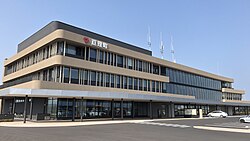|
Watari, Miyagi
Watari (亘理町, Watari-chō) is a town located in Miyagi Prefecture, Japan. As of 31 March 2020[update], the town had an estimated population of 33,459, and a population density of 450 persons per km2 in 12,643 households.[1] The total area of the town is 73.60 square kilometres (28.42 sq mi). GeographyWatari is located in the Tōhoku region of northern Japan, in the southeastern Miyagi Prefecture, bordered by the Pacific Ocean to the east. The Abukuma River flows through the town, forming its western border. Neighboring municipalitiesMiyagi Prefecture ClimateWatari has a humid climate (Köppen climate classification Cfa) characterized by mild summers and cold winters. The average annual temperature in Watari is 12.4 °C (54.3 °F). The average annual rainfall is 1,272.2 mm (50.09 in) with September as the wettest month. The temperatures are highest on average in August, at around 23.9 °C (75.0 °F), and lowest in January, at around 1.8 °C (35.2 °F).[2]
DemographicsPer Japanese census data,[4] the population of Watari has remained relatively steady since the turn of the 21st century.
HistoryThe area of present-day Watari was part of ancient Mutsu Province, and the place name of “Watari” appears in the Shoku Nihongi chronicles dated 718 AD. It was part of the holdings of Sendai Domain under the Edo period Tokugawa shogunate. Watari Town was established on April 1, 1889 with the establishment of the post-Meiji restoration modern municipalities system. It merged with the neighboring town of Arahama and villages of Yoshida and Õkuma on February 1, 1955. Watari was severely damaged by a tsunami caused by an earthquake on 11 March 2011.[5] Hundreds of people were stranded in a school but were airlifted from the roof by Japanese military helicopters.[6] The tsunami covered 47% of the town's area and 305 residents were reported killed or missing. GovernmentWatari has a mayor-council form of government with a directly elected mayor and a unicameral town council of 18 members. Watari contributes one seat to the Miyagi Prefectural legislature. In terms of national politics, the town is part of Miyagi 3rd district of the lower house of the Diet of Japan. EconomyThe economy of Watari is largely based on agriculture (strawberries) and commercial fishing and fish processing. EducationWatari has six public elementary schools and four public middle schools operated by the town government, and one public high school operated by the Miyagi Prefectural Board of Education. TransportationRailway
Highway
Local attractions
References
External links
|
||||||||||||||||||||||||||||||||||||||||||||||||||||||||||||||||||||||||||||||||||||||||||||||||||||||||||||||||||||||||||||||||||||||||||||||||||||||||||||||||||||||||||||||||||||||||||||||||||||||||||||||||||||||||||||||||||||||||||||||||||
Portal di Ensiklopedia Dunia




